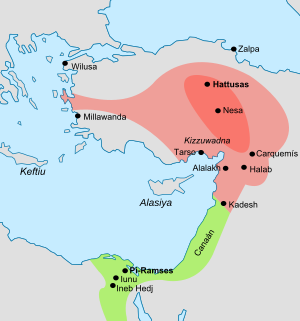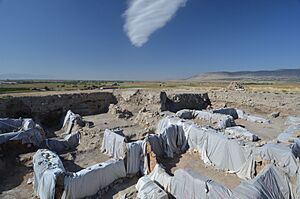Beycesultan facts for kids
Beycesultan is an ancient place in Turkey where archaeologists dig to find old things. It's located in western Anatolia, about 5 kilometers southwest of the city of Çivril in the Denizli Province. This historical site sits near an old part of the Büyük Menderes River.
Quick facts for kids
Beycesultan
|
|
|---|---|
Contents
A Look Back in Time: Beycesultan's History
Beycesultan was a very important place for thousands of years. People lived there for a long, long time!
Early Beginnings: The Stone Age
People first settled at Beycesultan a very long time ago, during the Late Chalcolithic period. This was a time when people used both stone and early metal tools. The settlement was quite large, like a big hill or mound, about 1 kilometer wide and 25 meters tall.
Growing Strong: The Early Bronze Age
As time went on, in the 3rd millennium BC, the town grew even bigger and more important. During this period, people built impressive religious buildings and other important structures for the community.
A Golden Age: The Middle Bronze Age

Beycesultan was at its busiest and most powerful around the start of the 2nd millennium BC. A huge palace and other buildings were constructed. However, this grand palace was later left empty and then destroyed around 1700 BC. During this time, Beycesultan was mostly connected to places in the west, like the Aegean Sea region and the island of Crete.
New Influences: The Late Bronze Age
After being mostly empty for a few hundred years, Beycesultan started to grow again. This time, it was more influenced by the powerful Hittites from other parts of Anatolia. Even though it was smaller than before, it was still an impressive city. This second period of growth ended suddenly around 1200 BC, when the city was completely destroyed. Many other places in Anatolia were also destroyed around this time.
Later Times
Even after these big destructions, people still lived at Beycesultan, though not as many. It was used during the Byzantine, Seljuk, and Ottoman periods. Some historians think it might have been an old Byzantine town called "Ilouza."
Uncovering the Past: Archaeology at Beycesultan
The site of Beycesultan actually has two main mounds, separated by an old trading road. The tallest part is the western mound, which is 25 meters high. The whole site stretches for about a kilometer.
In the early 1950s, an archaeologist named James Mellaart found some unique "champagne-glass" shaped pottery nearby. This discovery led him to the Beycesultan mound.
From 1954 to 1959, Seton Lloyd and James Mellaart led excavations at Beycesultan. They worked for the British Institute at Ankara for about two months each year.
More recently, from 2002 to 2007, Eşref Abay from Ege University started new surveys of the site. New excavations began under his direction in 2007, and work continues today with Adnan Menderes University.
Archaeologists have found some interesting things at Beycesultan. They found a row of small houses that were destroyed by fire. They also found a large palace. It seems the palace was emptied before it was destroyed.
Inside the palace, there was a special room near an entrance that might have been a kind of bathroom where visitors could wash. Another interesting feature was that some floors were raised about a meter above the ground, with small passages underneath. These might have been part of an early heating system, which would be very unusual for that time!
Outside the palace, archaeologists found a row of small shops. One of these shops seemed to be a Bronze Age pub! It had sunken pots for storing drinks and many glasses for serving customers. They even found knucklebones, which were used for a gambling game, just like games you might find in a modern bar.




